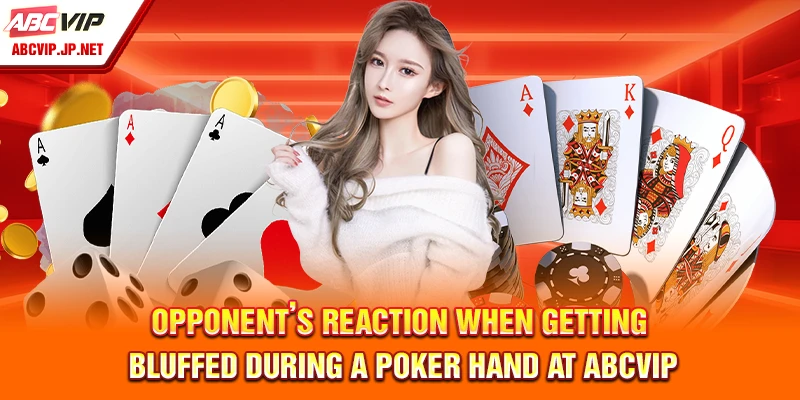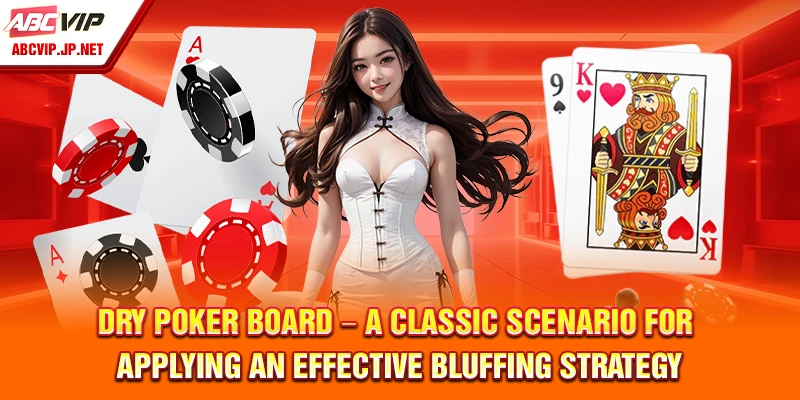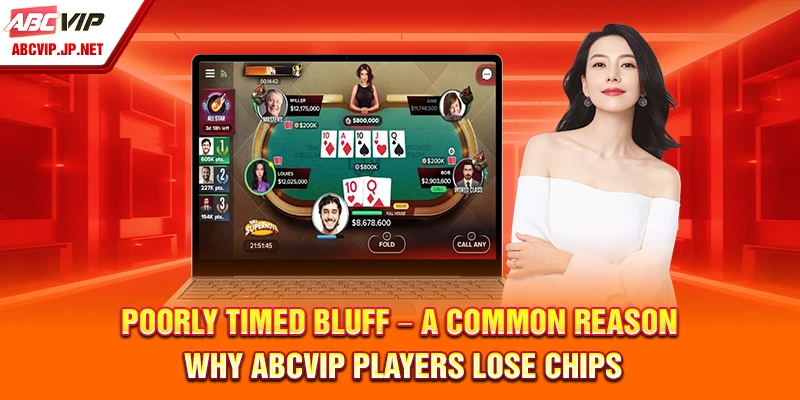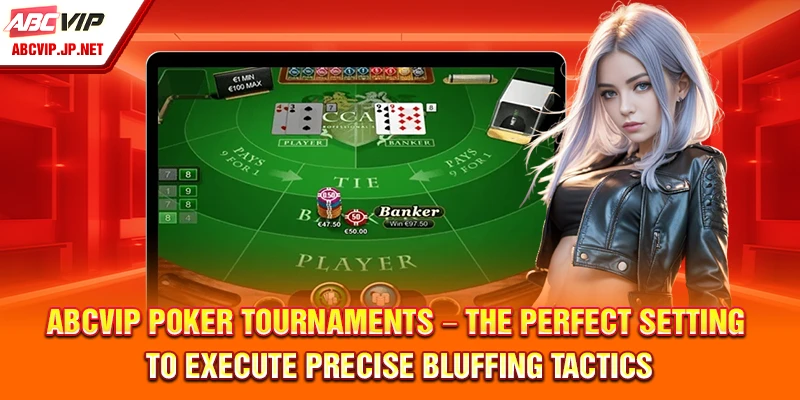Bluffing is one of the most crucial strategies in Poker, where skill and emotion intersect. At abcvip.jp.net, you’ll not only learn how to bluff at the right time but also master how to use it to control the game and improve your winning rate.
What Is Bluffing in Poker and Why It Matters
Bluffing is an essential part of the art of playing poker—especially for those seeking to control the pace of the table and apply psychological pressure on opponents. In simple terms, bluffing means making your opponent believe you hold a strong hand when in fact you don’t. When executed at the right time and against the right players, this strategy allows you to win pots without needing the best hand.
At ABCVIP, bluffing isn’t just a gamble. With tools like the integrated HUD, detailed hand history analysis, and a community of seasoned players, you can practice and refine your bluffing techniques session by session. More importantly, ABCVIP’s historical betting insights let you recognize ideal bluffing spots—and when it’s best to hold back.
So what’s the difference between a bluff and a semi-bluff? And how do you know when it’s the right time to bluff? Let’s explore these questions in detail in the following sections:
Defining Bluffing and Its Psychological Purpose
Bluff is intended to create the illusion that you’re in a strong position. This psychological trick puts pressure on your opponent, pushing them to fold—allowing you to win the pot without needing to reveal your cards. The goal is to seize psychological momentum and steer the tempo of the hand. Bluffing is especially effective on tight tables or when you are in a late position, controlling the betting flow.
How Is a Bluff Different From a Semi-Bluff?
Semi-bluffing happens when you’re bluffing but still have potential to improve your hand on the turn or river—for instance, holding a flush or straight draw. This technique sits between a pure bluff and a value bet, giving you extra equity if your opponent calls. ABCVIP offers hand chart tools to help you evaluate draw potential at each stage of the hand.

When to Bluff – Identifying the Right Timing
Bluffing is not always the right move. In poker—especially when playing at ABCVIP—timing is everything when it comes to the effectiveness of your bluff. A poorly timed bluff can cost you your entire stack, while a well-executed one can turn the tide in your favor and help you dominate the table.
Successful players usually bluff only when the necessary conditions are met: a favorable board, an opponent prone to folding, good position, and previous betting patterns that support a believable “story.” At ABCVIP, the hand history tracker lets you analyze the success rate of past bluffs, helping you refine your timing.
Let’s break down two of the most important timing elements in bluffing:
Bluff Effectively on Dry Boards
Bluff is intended to create the illusion that you’re in a strong position. A “dry” board—meaning one with low draw potential or hand connectivity (e.g., K♦–7♣–2♠)—is an ideal scenario for bluffing. Since these boards don’t support many drawing hands, your bet is more likely to raise suspicion and pressure opponents into folding.
At ABCVIP, you can practice these scenarios at low-stakes or freeroll tables where observing opponent reactions to dry boards becomes a valuable training ground.
Identifying Opponents Who Are Prone to Folding
Not every opponent is a good target for a bluff. Players who follow a tight playing style—rarely calling or re-raising—are the prime targets. To identify them, look back at previous hands: do they fold when raised? Are they hesitant to call down bets on the river?
ABCVIP’s HUD provides real-time stats like VPIP (Voluntarily Put $ In Pot), Fold to C-Bet, and other key metrics to help you make informed decisions. Especially when you’re in late position and can observe how your opponent has acted earlier in the hand, your chances of a successful bluff increase significantly.

Advanced Bluffing Techniques for Experienced Players
Once you understand the basics and know when to bluff, advanced players need to level up by learning how to craft a convincing betting narrative and optimize bluffing strategy using data and behavioral analysis. This is where advanced bluffing techniques truly shine.
At ABCVIP, skilled players combine probability theory, positional awareness, and betting history to develop optimal bluffing strategies. Bluffing should never be random—it must always be supported by logic, context, and consistency within each hand.
Let’s dive into two critical techniques that seasoned players often use:
Polarized Ranges and River Bluffing
One of the most advanced concepts in modern poker is the construction of a polarized range—continuing to bet on the river only with either very strong hands or complete bluffs. This makes your actions harder to interpret and forces opponents to make difficult decisions when calling.
For example, if you call pre-flop, bet the flop and turn, and continue betting heavily on a dry river board, your opponent is likely to assume you have either a premium hand or are making a bold bluff. Maintaining a balanced bluff-to-value ratio (according to Game Theory Optimal or GTO principles) is key to preventing opponents from exploiting your strategy.
Leveraging Position and Table Image
Bluffing becomes significantly more effective when you’re in late position—allowing you to act after your opponents and base your decisions on more information. Sitting in early position greatly increases your risk, as players after you have more control over the pot.
Additionally, your table image plays a vital role. If you’ve been playing tight for several orbits and then attempt a bluff, your success rate will be much higher. On the other hand, if you’ve just made an obvious failed bluff, it’s better to wait a few rounds before trying again to rebuild your credibility.

Common Bluffing Mistakes and How to Avoid Them
Bluffing is an art—but when misused, it can quickly turn into a double-edged sword. One of the top reasons players lose chips at ABCVIP Poker tables is poor bluff execution—bluffing at the wrong time, targeting the wrong opponents, or doing it so predictably that it becomes easy to exploit. Understanding common mistakes and learning how to avoid them is essential for every player.
New players often bluff based on emotion—trying to “get revenge,” avoid looking weak, or worse, bluffing with no plan at all. Below are two of the most common bluffing errors and how to prevent them:
Overbluffing and Revealing Patterns
Overbluffing means bluffing too frequently, making your patterns easily detectable. For example, if every time you check-raise it turns out to be a bluff, your opponents only need to call a few times to figure you out. Other giveaways include inconsistent bet sizing or unusual hesitation that signals bluffing behavior.
At ABCVIP, you can review your betting history and win probability to spot these repeated behaviors. The key is to build a balanced range—making your actions look the same whether you’re holding a strong hand or executing a bluff. This makes your overall strategy harder to read.
Bluffing the Wrong Opponent or at the Wrong Time
Trying to bluff a loose player (who calls everything) is a recipe for failure. Such opponents don’t rely on logic; they’re simply curious to see your cards. Similarly, bluffing with a short stack is often a bad idea because you lack the chip equity needed to force a fold.
So what’s the solution? Target tight opponents, play with stack sizes similar to theirs, and leverage positional advantage. Observe several hands before making your move to better understand your opponents. ABCVIP allows you to take personalized notes on players, making opponent profiling more accurate and efficient.

Bluffing in ABCVIP Poker Tournaments – What Makes It Different?
Bluffing in tournaments differs significantly from bluffing in cash games. At ABCVIP, Poker tournaments often feature escalating blinds, chip disparities, and pressure from payout structures—meaning every bluff doesn’t just affect one hand, but your entire trajectory in the competition.
This means you must reassess the value of bluffing at different tournament stages—early game, middle game, and late game—rather than relying on a fixed strategy. Let’s examine two strategic elements that define successful tournament bluffing:
Bluffing in Early Game and Bubble Stage
In early stages, stacks are typically deep, and players aren’t too concerned about busting out. This is a good time to try calculated bluffs—but do so conservatively to avoid unnecessary chip loss.
However, during the bubble stage—when only a few players remain before payouts begin—most opponents become highly risk-averse. This is the golden moment to bluff. Mid-stacked players, in particular, will often fold marginal hands to avoid elimination. ABCVIP provides tools to track your current position and assess ICM (Independent Chip Model) scenarios, helping you decide if a bluff is worth the risk.
Bluffing While Short-Stacked – Yes or No?
When you’re short-stacked, every bluff becomes a high-stakes gamble. In most cases, it’s best to avoid bluffing because you simply don’t have enough chips to apply real pressure, and the risk of busting is too great.
However, there are exceptions: if you’re in a late position, everyone before you has folded, and the big blind is known to be tight, then it might be a great time for a “steal bluff.” This low-risk move can help you survive longer and possibly rebuild your chip stack.

If you’re looking to improve your win rate, don’t miss our detailed Game Strategy Guides tailored for every game type.
Conclusion
Bluffing is not just a technique—it is a sophisticated strategic art form in Poker. From understanding the fundamentals of bluffing, identifying ideal timing, mastering advanced techniques like polarized ranges, to avoiding common pitfalls and adapting your play during tournaments—each of these elements plays a vital role in helping you improve your win rate and maintain psychological dominance at the table.
At ABCVIP, you not only gain access to a transparent and modern Poker platform, but also a comprehensive suite of tools such as hand history tracking, opponent behavior analysis, HUD statistics, and in-depth learning resources from a community of seasoned players.
And remember: bluffing is only effective when combined with sharp observation, precise calculation, and emotional control. Consistent practice, reviewing past hands, and learning from more experienced players are the keys to turning bluffing into your most powerful weapon.

